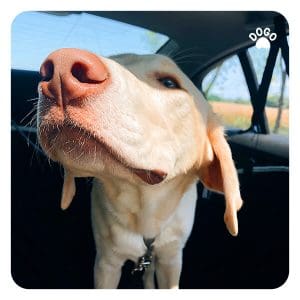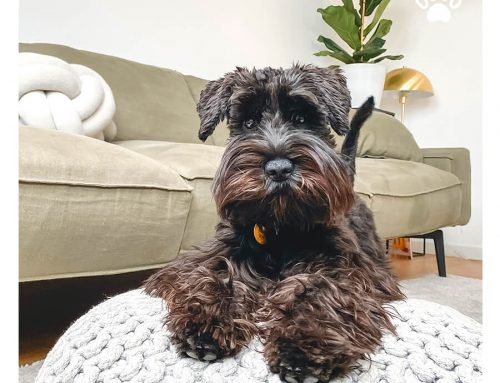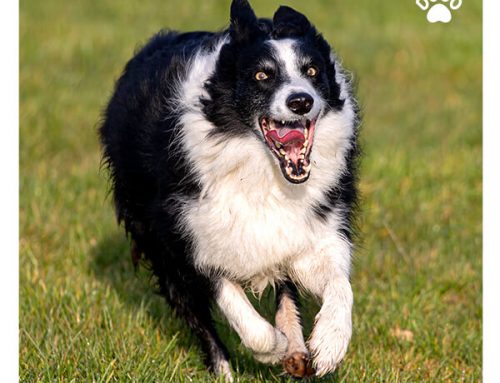
Intense anxiety can manifest in the dog by denying entry into the car, panting, whimpering inside the vehicle, and even diarrhea or vomiting. Read our practical guide to prevent your dog from being stressed out in the car.
Familiarising with the Car
Regardless of your dog’s age, it is a good idea to gradually accustom your dog to the car and to traveling in it.
In the case of a puppy, the ideal moment to get them accustomed to the vehicle is during the socialization period between 8 and 16 weeks of age. In case of a new situation, getting used to it should be gradual. You should first show a car to a puppy, then take them for a short ride, etc. The best way is to take your pup with the vehicle to a park for a long walk or to some other attractive place. It will create positive associations with the car ride. Make sure to reward your puppy for any desired behavior inside the car.
When it comes to adult dogs, this may be more difficult as the canine may already have a negative association with a car ride. So it may take a little longer to teach it, but it’s not impossible.
A dog adopted from a shelter could be thrown out of the car or forced into the vehicle and only taken to unpleasant places. Then the car will not trigger positive associations.
Nothing by All Means
If your dog is stressed out in the car, start familiarizing both a puppy and an adult dog by allowing the dog to enter the car freely. Never force the dog in because it will only make the problem worse. Instead, the dog should have time to sniff the car and decide for themselves whether to enter it or not.
When your dog doesn’t want to get into the car at all, don’t force them into it. In such a case, show them that being near a car is connected with something great. For example, you can play with your pet not far from the car and gradually reduce the distance.
Teaching to Get Used to the Car

During that time, you can reward the dog or, for example, give them something to chew (natural chews, favorite rubber toy, etc.). A toy will additionally lower the stress level in your pup’s body. If your dog tolerates being in a car well, you can try going for short rides. It’s best to go to places interesting for a dog so that they know that driving a car is connected with something fun.
It can be helpful to create a positive association with the car by making it a comfortable and enjoyable place for your dog. You can place your dog’s favorite blanket or toy inside the car to make it feel more familiar and cozy. Additionally, you can play calming music or use calming sprays or pheromones to help your dog relax during the ride. If your dog is particularly anxious, you may want to consider using a crate or carrier to provide a sense of security. With patience and positive reinforcement, you can help your dog overcome their fear of car rides and enjoy traveling with you.
Of course, there are situations when you need to transport a dog somewhere without preparation—for example, taking a dog from a shelter to your home, an emergency visit to the vet, etc. However, do your best to reduce the number of similar events so that the dog does not acquire negative associations.
Motion Sickness
When a dog travels badly for health reasons, for example, suffering from motion sickness, the problem is more complex. In that case, the dog already associates seeing the car with feeling sick. Motion sickness can trigger vomiting and diarrhea.
To minimize your dog’s discomfort during the trip, it is advisable to visit a vet for a prescription of appropriate medication. In addition, make sure not to give food a few hours before the ride and provide fresh air during the journey, open the window, take more frequent breaks en route and give the dog water.
Safety

These accessories will protect the dog in case of sudden braking and limit the possibility of movement in the car. A dog in panic, for example, may want to get to the owner, get under the pedals or limit the driver’s visibility.
It’s important to note that laws regarding dog safety while traveling vary by location. Some states require that dogs be restrained while traveling in a vehicle, and failure to comply can result in fines or other penalties. Even if your state does not have specific laws regarding dog safety, it’s still important to take precautions to protect your pet and yourself while driving. In addition to using safety belts or harnesses, you may want to consider using a barrier or divider to separate your dog from the front seats. This can prevent distractions and keep your dog from interfering with your ability to drive safely. By taking the necessary safety measures, you can ensure that both you and your furry friend have a safe and enjoyable car ride.
Before a Car Ride
To make the ride as comfortable as possible, here are a few rules to keep in mind. We are sure that they will help you reduce your dog’s stress level while traveling in a car.
- Take a walk before the trip so your dog can meet their physiological needs.
- Always have fresh water for your dog.
- If you are planning a long journey, prepare a Kong toy or a chew for your dog to occupy them while driving.
- Bring a blanket or a favorite bed in the car.
- Do not drive abruptly.
- Take breaks from time to time to allow your dog to stretch and do potty.
- Always have a first aid kit ready.
- Do not leave your dog alone in the car, even with the windows open.






